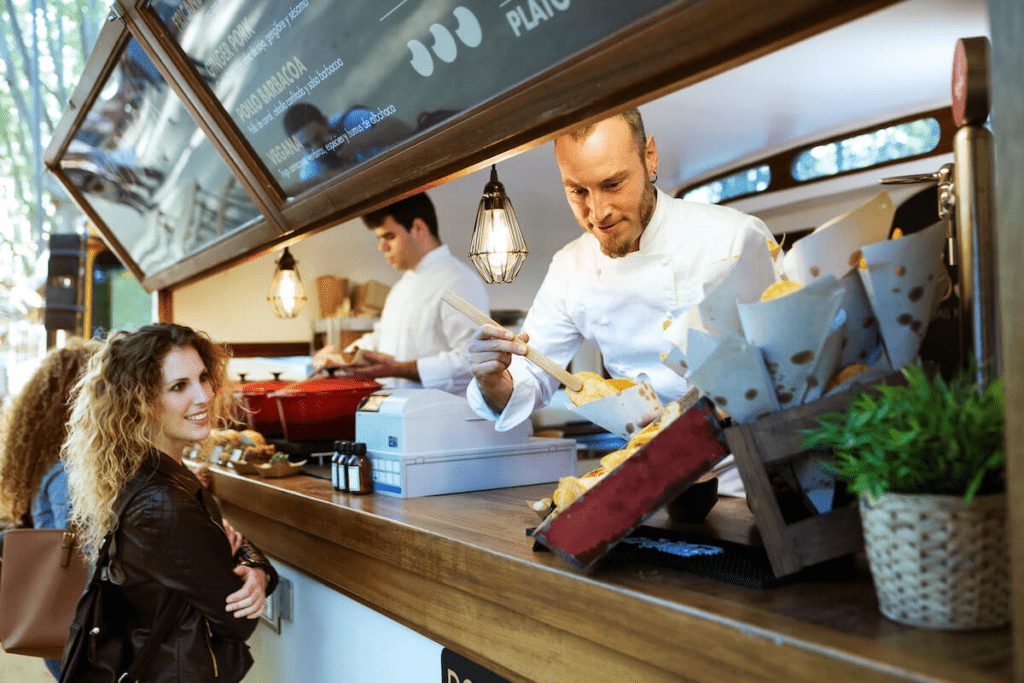Key Takeaways:
Although voice artificial intelligence (AI) is still in its infancy, the technology holds massive potential for many different industries and is already being used by forward-thinking businesses. Voice AI technologies run the gamut from automated phone system voice-overs to digital assistants.
Quick service restaurants incorporating digital voice AI platforms to make their operations more efficient is a prime example of the cutting-edge AI-based applications already available in 2022. Voice AI ordering systems armed with speech recognition and voice generator capacities quickly and accurately record and transmit guest orders, allowing team members to attend to other tasks.
Contemporary voice AI shows incredible potential to transform the food service industry, enabling restaurants to provide better service and to stay open, even when short-staffed, and to increase overall productivity.

Consumers and businesses alike utilize voice AI technology on a regular basis: 40% of American households used voice search functions in 2019, and digital assistant usage (e.g. Alexa) will double to 8.4 billion by 2024. Additionally, 63% of surveyed CEOs predicted that AI will initiate job growth in the same manner as the introduction of the internet.
Today voice AI is far more advanced already than people think:
This rapid technological progress couldn’t come at a better time for struggling restaurants. Staff shortages require employees to multitask beyond the typical expectations of their job roles. Voice AI programs will reduce some of the burden on stressed-out team members, so they can focus on food prep and in-person service rather than having to juggle tasks with answering the phone.

Lost revenue due to the COVID-19 pandemic and the ongoing industry labor shortage continue to take a dual toll on restaurant bottom lines. Restaurant voice AI technology offers an abundance of potential use cases to help turn things around.
At the most basic level, interactive voice response (IVR) phone systems use automated voice overs to guide callers through a predetermined, menu-based pathway, removing the need to assign a team member to take phone orders. But IVR systems are limited and outdated, frustrating guests who have to wait to hear all the options before choosing how to proceed and often not ending up where they want to go, due to difficulties of navigating the preset pathway.
Recent developments, however, allow voice AI platforms to be more dynamic in interacting with guests. They take accurate, real-time transcriptions of guest orders and utilize context clues and prior guest interactions to recommend personalized order suggestions, including upsells. In addition, voice cloning technology allows a manager or team member to record their own voice or the voice of a restaurant mascot for usage in these interactions for a truly custom guest experience that outshines IVR systems of the past.
Restaurant voice AI tech isn’t restricted to phone systems. Drive-thru kiosks can also use voice AI software, allowing restaurants to further optimize an ordering method that many guests prefer due to speed and convenience.
Not only do restaurant voice AI technologies maintain service speed and order accuracy, they actually boost it. Faster order fulfillment allows restaurants to serve more guests in the same span of time, while improved order accuracy leads to greater diner satisfaction and a higher likelihood of returning.
In addition to directly recording orders, restaurant voice AI systems enable food service franchises to operate with greater efficiency. For example, voice AI simplifies the tedious process of tracking and ordering inventory by allowing managers to record this information vocally rather than by hand.
On a similar note, restaurants with table service are able to use voice AI and waitstaff in conjunction. Instead of writing down orders and later entering them into the POS system, servers can instead verbally transcribe guest menu choices into a mobile voice AI device. This also allows diners to correct errors before they occur since any missteps on the part of the waitstaff will occur right in front of them.
Restaurant guests aren’t the only ones benefiting from restaurant voice AI technology: this technology also alleviates strain on overworked team members.

One of the myriad consequences of the Great Resignation is the resulting stress on restaurant staff. 2021 employment figures gathered by the Bureau of Labor Statistics reveal that not only did a record 4.5 million Americans quit, but that no industry endured more job losses than food service. Consequently, short-staffed restaurants now rely on their existing team to compensate for job vacancies by working in more roles.
Restaurant voice AI ordering assistants reduce the need for team members to excessively multitask, thus raising staff morale. This, in turn, improves employee retention numbers by reducing turnover.
Because voice AI ordering assistants can interface across all ordering channels, team members released from order taking will instead attend to higher-priority tasks or duties with more customer service value. Plus, voice AI’s capacity to receive and record multiple orders across multiple channels simultaneously pays major dividends. Specifically, reduced guest wait time means staff no longer need fret over steadily lengthening waiting lines and increasingly irritated, impatient diners.
A less chaotic and calmer workplace fosters an enjoyable and rewarding job environment. Allowing employees to focus their attention on higher-value job tasks may lead to them feeling that management recognizes their talents.
Reducing employee workload also gives them time to seek mentoring, leadership training and other career development and advancement opportunities. Engaged employees who view their job as a career and not merely a temporary gig will likely prove to be any business’s most valuable and productive workers.
Restaurants utilize voice AI to provide guests with a better experience. To that end, staff members always work in parallel with the AI platforms. They’re ready to assist diners experiencing difficulties with the technology or who simply prefer to talk to an employee.

Despite the complexities of speech synthesis, high-quality voice AI platforms are now sophisticated enough to offer tangible benefits to quick-service restaurants without compromising service standards.
Restaurant voice AI software interfaces with existing phone networks and ordering kiosks to seamlessly transition to an automated ordering system that improves order transcription accuracy and allows team members to focus on other tasks.
ConverseNow offers best-in-class voice AI technology to transform your day-to-day restaurant operations. We’ve developed industry-leading natural language processing (NLP), natural language understanding (NLU) and text-to-speech technology. Our revolutionary voice AI virtual ordering assistants quickly pay for themselves, as they can double productivity during busy hours, increase average ticket up to 30%, and boost same-store revenues by as much as 20%. Head to ConverseNow.ai to learn more.